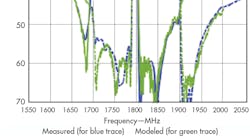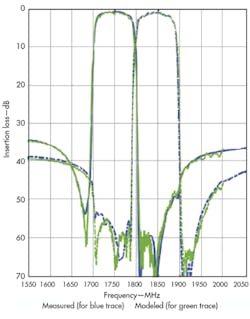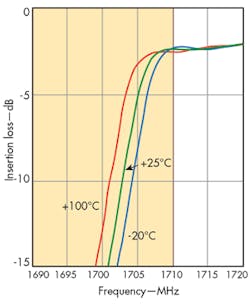This file type includes high resolution graphics and schematics when applicable.
Filters control the congestion of modern communications signals. They are essential for preventing interference in electronic systems but can be challenging to implement, especially as mobile communications devices continue to increase functionality in ever-smaller packages. Taking a fresh look at RF filters, Resonant applies modern design strategies such as finite-element analysis (FEA) to the creation of acoustic-resonator filters, creating surface-acoustic-wave (SAW) filters with performance comparable to bulk-acoustic-wave (BAW) filters, but in fractions of the time and cost normally required for BAW filters. Then they license rather than sell the designs to customers seeking miniature high-performance RF filters for mobile devices and other wireless products. The secret ingredient in this innovative approach to building RF filters is Resonant’s Infinite Synthesized Networks (ISN) design process.
Resonant works closely with commercial SAW foundries to account for known process variations as part of a filter design, to achieve BAW-like performance from commercial SAW fabrication processes. Faced with the challenge of developing a duplexer to filter the separate receive and transmit frequency bands within a Fourth-Generation (4G) cellular Long-Term Evolution (LTE) mobile handset, but not wishing to incur the cost of a BAW process, the firm relied on the ISN design approach to transcend the limitations of working with a particular SAW fabrication facility. Acoustic wave filters have traditionally employed ladder networks synthesized with the aid of foundry-based empirical models to achieve target performance levels. Under certain conditions, such as narrow operating temperatures, this can be successful. But faced with the real-world operating conditions of mobile LTE handsets, BAW filters and duplexers typically suffer less performance degradation at higher power levels and temperature extremes.
Resonant’s engineers sought a means of including different behavioral mechanisms into a SAW filter design, such as linearity from high signal power levels and frequency variations due to temperature, while working within the boundaries of a given SAW device fabrication process. The ISN approach to designing SAW filters builds upon electromagnetic (EM) FEA simulation and the flexibility to modify input data to compensate for different SAW foundry lithography tolerances and variations. The ISN approach has made it possible to optimize filters for distortion-free performance with the higher-power signals typically found in LTE wireless networks and to optimize performance for different operating temperatures, including the higher temperatures produced within energy-dense LTE mobile devices.
As evidence of the effectiveness of the ISN approach, a low-cost, miniature SAW duplexer was developed for LTE Band 3 use, where the uplink (from the handset to the base station) frequency range is from 1710 to 1785 MHz and the downlink (from the base station to the handset) frequency range is from 1805 to 1880 MHz downlink. Duplexers modeled with the ISN software and then fabricated and tested at a commercial SAW foundry showed a close match between simulated and measured performance for the two passbands (Fig. 1).
This particular duplexer includes closely spaced passbands, where the goal is to achieve low passband loss while also providing high isolation between the passbands. Since these are miniature filters with wafer-level packaging, a commercial wafer prober and vector network analyzer (VNA) are enlisted for the measurements, gauging loss from antenna to transmit port and antenna to receive port for realistic values. The typical loss for an individual duplexer in the center of each passband was 0.9 dB, with loss rising to no more than 2.2 dB at the transmit frequency band edges (critical for power amplifier efficiency). The isolation between passbands was typically 54 dB.
Perhaps even more impressive was how little the insertion-loss performance varied with frequency as a function of temperature, when measured across a wide range from -25°C to 100°C. Designed with the Resonant ISN tools, the passband responses of these SAW duplexers changed 3.4 MHz in frequency for that wide temperature range, or a shift of only 17 ppm/°C (Fig. 2). The ISN design tools can model the characteristics of lithium tantalate and composite/bonded substrate materials used by commercial SAW foundries to account for the effects of temperature and power, and create designs that maintain high linearity even at higher power levels such as those found in 4G LTE handsets. The filters and duplexers are also quite compact and low-profile, measuring just 1.8 × 1.4 × 0.38 mm to fit the high-density packaging requirements of modern smartphones and mobile devices. More about the company and the ISN design process is available in a white paper available for free download from the Resonant website.
Resonant Inc., 110 Castilian Dr., Ste. 100, Goleta, CA 93117; (805) 308-9803, www.resonant.com
This file type includes high resolution graphics and schematics when applicable.




